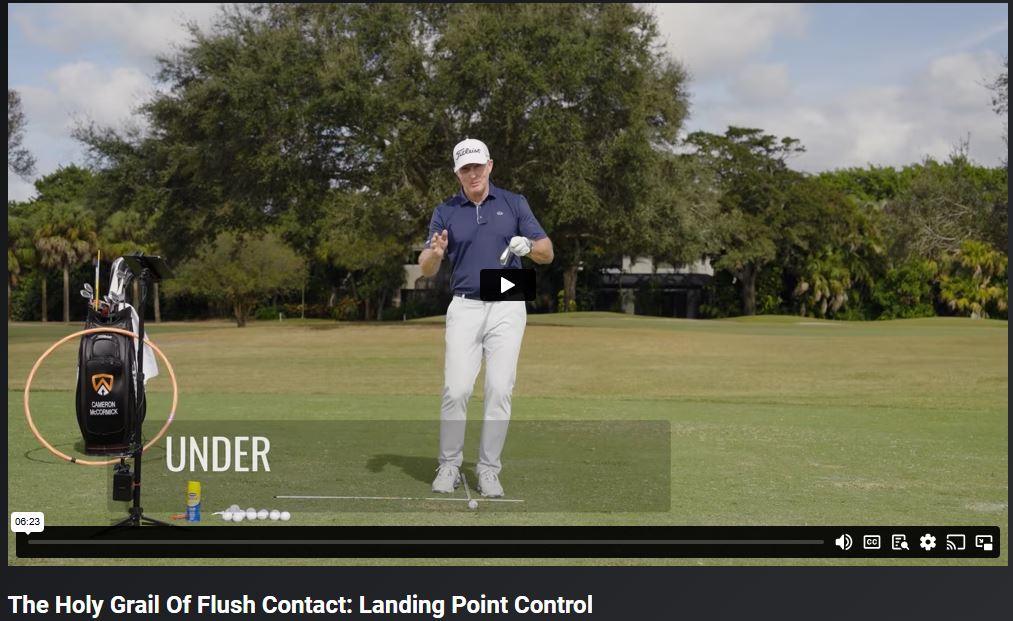What Is the Ball Backwards Performance Golf Blueprint: A Step-by-Step Guide to Mastering Reverse Swing Mechanics
The Ball Backwards Blueprint represents a fresh approach to golf instruction that focuses on improving iron play through contact-first training. This method, created by Golf Digest Top 5 Coach Cameron McCormick, helps players achieve better ball striking by working backwards from ball flight patterns instead of making major swing changes.

Most golfers struggle with inconsistent iron shots and spend countless hours trying to fix their swings. The Ball Backwards striking method takes a different path by teaching players to understand their contact patterns first. This approach has earned high ratings from thousands of golfers who report more consistent iron play.
The program combines video training with practical drills that help golfers identify their lead issues affecting ball contact. Rather than overwhelming players with complex swing mechanics, it breaks down improvement into simple, manageable steps that can be practiced at home or on the range.
Key Takeaways
- The Ball Backwards Blueprint teaches consistent iron play by focusing on contact patterns before swing mechanics
- Players learn to diagnose their ball flight issues through simple, targeted practice drills
- Video training and interactive sessions help golfers improve without major swing changes
Understanding the Ball Backwards Theory

The Ball Backwards technique is a revolutionary golf training method focused on improving iron play consistency. This approach helps golfers enhance their ball striking without making major swing changes.
The core principle centers on shaft lean at impact, which affects shot quality and trajectory. Proper shaft lean creates better contact and more predictable results.
Golf instructors have found that players who master this method often eliminate common mistakes like:
- Fat shots
- Thin contact
- Inconsistent ball flight
- Poor distance control
This technique gets its name from the focus on working backwards from the impact position. Players learn to position their body and club correctly at the moment of contact before working on the rest of their swing.
Top golf coaches endorse this method because it simplifies the learning process. Instead of overwhelming players with complex swing mechanics, it zeroes in on the most crucial moment - impact.
The training emphasizes practical drills and simple adjustments that produce quick improvements. Players can practice these concepts at home or on the range without special equipment.
Research shows that golfers who implement these principles often see faster progress compared to traditional teaching methods. The focus stays on fundamentals rather than getting lost in technical details.
Fundamentals of the Performance Golf Blueprint

The Ball Backwards approach focuses on three core elements that work together to improve iron play consistency and ball striking ability. These fundamentals create a solid foundation for golf improvement.
The Role of Equipment
Proper club fitting plays a vital role in the Ball Backwards Blueprint. Custom-fitted irons help golfers achieve optimal contact with the ball.
Club length, lie angle, and shaft flex must match the player's physical attributes and swing characteristics. This ensures consistent ball striking.
The right grip size improves control and reduces hand tension during the swing. Many players use grips that are too small or large.
Essential Equipment Checklist:
- Properly fitted irons
- Correct shaft flex
- Appropriate grip size
- Clean club faces
- Quality golf balls
Physical Fitness and Conditioning
Strong core muscles and flexibility enable golfers to maintain proper posture throughout the swing. Regular stretching helps prevent injury and improves range of motion.
Balance exercises enhance weight transfer ability, which is crucial for proper golf swing mechanics.
Key Physical Components:
- Core strength
- Hip mobility
- Balance training
- Upper body flexibility
- Lower body stability
Mental Game Strategies
A clear pre-shot routine helps golfers maintain focus and consistency. This includes visualization of the desired shot shape and trajectory.
Simple swing thoughts keep players relaxed and confident during their swing. Complex technical thoughts often lead to tension.
Positive self-talk and staying present help manage on-course stress. Many players perform better when they focus on one shot at a time.
Mental Game Tips:
- Establish pre-shot routine
- Practice visualization
- Use simple swing thoughts
- Stay present-focused
- Maintain emotional control
Applying the Blueprint to Your Game
Free Lesson On Exactly What The Ball Backwards Program Is All About. Click Below
The Ball Backwards Blueprint method focuses on working backward from ball flight to fix swing mechanics and improve contact consistency. Proper implementation requires systematic practice and goal-setting.
Assessing Your Current Skills
Players should start by filming their swing from face-on and down-the-line angles. This provides a baseline for tracking progress.
Take detailed notes on current shot patterns, including typical misses and ball flight tendencies. Pay special attention to contact quality with irons.
Track statistics for 10 rounds, focusing on:
- Greens in regulation
- Fat/thin contact frequency
- Ball flight direction patterns
- Distance control consistency
Setting Golfing Goals
Set specific, measurable goals based on the initial assessment:
Short-term Goals (1-2 months)
- Improve solid contact rate by 25%
- Reduce fat shots to less than 2 per round
- Master the Simple Strike Sequence
Long-term Goals (3-6 months)
- Achieve 80% consistent center contact
- Develop reliable ball flight patterns
- Lower scores by 3-5 strokes
Creating a Tailored Practice Schedule
Dedicate 70% of practice time to ball striking drills focused on contact quality.
Structure practice sessions into three parts:
- Technical drill work (20 minutes)
- Contact practice with feedback (30 minutes)
- On-course situation simulation (30 minutes)
Use alignment sticks and impact tape to track progress. Schedule three 30-minute sessions per week minimum.
Record swing video every two weeks to monitor changes and ensure proper implementation of the blueprint concepts.
Techniques for Ball Backwards Execution
Creating backspin requires precise technique and proper execution of key fundamentals. The right combination of ball position, swing path, and body alignment helps generate the ideal backspin for optimal ball control.
Mastering Ball Position
The golf ball should be positioned slightly forward of center in the stance when attempting to create backspin. This setup allows for a steeper angle of attack.
The ideal ball position varies based on club selection. For short irons, place the ball just left of center. For mid-irons, move it slightly more forward.
Quality golf balls designed for spin are essential for achieving maximum backspin. Clean grooves on the clubface also help create more friction at impact.
Swing Path Adjustments
Players must strike down on the ball with a descending blow to generate backspin. The steeper angle creates more friction between the club and ball.
The hands should lead the clubhead through impact. This promotes the downward strike needed for proper spin generation.
Trail hip rotation plays a crucial role in maintaining the proper swing path. Avoid sliding or swaying during the downswing.
Stance and Posture Optimization
A stable, athletic stance provides the foundation for consistent backspin creation. Feet should be shoulder-width apart with weight evenly distributed.
The spine angle must remain constant throughout the swing. This helps maintain the proper attack angle into impact.
Knees should flex slightly with arms hanging naturally from the shoulders. This balanced setup allows for proper weight transfer during the swing motion.
Weight distribution shifts slightly toward the lead foot during the downswing. This promotes the descending blow needed for optimal backspin.
Advancing with Advanced Drills
The Ball Backwards method includes several advanced drills to help golfers master consistent iron play. These drills focus on proper body rotation and club path.
Tour-level ball striking consistency comes from practicing specific movements that promote clean contact. Players should start with simple drills and gradually increase complexity.
A key advanced drill involves approaching the ball from a low and inside path. This helps create the ideal club head position at impact.
Advanced Drill Progression:
- Start with half-speed swings
- Focus on maintaining spine angle
- Practice arm rotation drills
- Add speed gradually
- Track progress with video
Using a swing speed radar device helps players monitor their progress. This tool provides immediate feedback on club head speed and contact quality.
Players should practice these advanced drills for 15-20 minutes per session. Quality repetitions matter more than quantity.
The Ball Backwards Blueprint teaches players to maintain consistency while increasing swing speed. This combination leads to better ball striking and more accurate shots.
Tracking Progress and Adjusting the Plan
Progress tracking plays a vital role in golf improvement. Players need to measure their results and make adjustments based on performance data.
The Ball Backwards Blueprint emphasizes continuous evaluation and goal adjustment throughout the learning process. Players should track key metrics like:
Key Metrics to Monitor:
- Strike quality and consistency
- Ball flight patterns
- Distance control
- Contact point location
- Practice session outcomes
Regular progress monitoring helps identify areas that need extra attention. Players can use video recording, launch monitors, or simple scoring systems to track their development.
Breaking down goals into smaller steps makes improvement more manageable. A player might focus on mastering one aspect of the technique before moving to the next level.
If certain drills or movements aren't producing results, players should adjust their practice routine. This might mean spending more time on fundamentals or modifying drill techniques.
Quick feedback loops help accelerate learning. Players should note immediate results after each practice session while also tracking longer-term progress patterns.
Leveraging Technology and Analytics
Modern golf tech gives players powerful tools to improve their game. Smart ball technology tracks crucial metrics like speed, distance, and ball control in real-time.
Advanced sensor systems analyze every swing, measuring factors like shot distance, club speed, and ball spin rate. This data helps players identify patterns and areas for improvement.
Equipment manufacturers now integrate analytics directly into clubs. Cobra Golf's KING F8 line features smart grips with embedded sensors to track performance metrics automatically.
Players must consider multiple data points before each shot:
- Club selection
- Ball type
- Course temperature
- Air moisture
- Wind direction
Swing analysis technology provides instant feedback to help golfers make targeted improvements. This leads to more consistent ball striking and increased distance.
Popular tracking systems like Arccos Golf, Garmin, and Shot Scope give players detailed performance insights. These tools help identify strengths and weaknesses in real-time.
Frequently Asked Questions
The Ball Backwards Performance Golf Blueprint teaches players to hit more consistent iron shots through specific ball position and impact techniques. Many golfers report improvements in their iron striking within the first few practice sessions.
How can the Ball Backwards Performance Golf Blueprint improve my game?
Ball Backwards striking techniques help golfers hit more solid iron shots by focusing on proper impact position. The method eliminates fat shots and improves contact consistency.
The program includes video training and a printable guide that breaks down the key movements step by step.
What are the main principles of the Ball Backwards Performance Golf Blueprint?
The system centers on positioning the golf ball and achieving proper impact alignment. Players learn to strike down on the ball with the correct shaft lean.
The method uses Trackman data points to validate the techniques and ensure measurable results.
Is the Ball Backwards Performance Golf Blueprint suitable for beginners?
The program works for golfers of all skill levels since it focuses on fundamental impact principles. New players often see quick improvements because the concepts are simple to understand and practice.
The video lessons break down complex moves into basic steps that beginners can follow.
What are the differences between the 2021 version and previous versions of the Ball Backwards Performance Golf Blueprint?
The 2021 version includes updated video lessons and enhanced interactive training elements. The program now features live Q&A sessions where players can get direct feedback.
The printable guides contain new practice drills based on user feedback and success patterns.
How does the Ball Backwards Performance Golf Blueprint address the ball rollback debate?
The program teaches strike patterns that work with both current and proposed golf ball specifications. The focus remains on clean contact and proper impact, which stays relevant regardless of equipment changes.
The techniques align with USGA testing guidelines for ball performance.
What are some success stories or testimonials from using the Ball Backwards Performance Golf Blueprint?
The program maintains a 4.8 rating based on over 3,700 reviews. Users report hitting their irons more solidly and reducing fat shots within weeks.
Many golfers note improved consistency and better distance control with their iron play.


